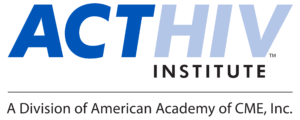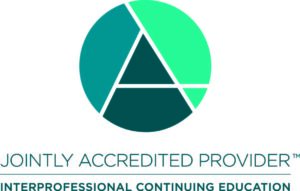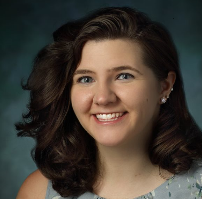Case Studies in ART and Retention in Care
|
Release Date: October 2, 2024 |
 |
Support for this activity has been made possible through an educational grant from Gilead Sciences. |
Webinar Highlights:
It is estimated that approximately 54% of patients with HIV in the United States were retained in care in 2022. By remaining engaged in care, patients are more likely to be adherent to antiretroviral therapy resulting in viral suppression, improved patient outcomes and prevent the spread of HIV.
Through a series of cases, our interprofessional faculty educators will discuss potential barriers to retention in care commonly encountered by the healthcare team and provide strategies and recommendations to improve retention with a focus on interdisciplinary teamwork.
Learning Objectives
- Explain the role of immediate access to HIV care and treatment in key HIV care continuum metrics and strategies to address barriers to same day treatment access.
- Identify common barriers to retaining patients with HIV in care and strategies to overcome these barriers.
- Describe the role that various healthcare professionals play in retaining patients in care including physicians, nurse practitioners, physician assistants, nurses, pharmacists, social workers, case managers, and mental health providers.
What You Can Expect:
- Practical Application of the Science: Our expert faculty educators will guide you through this engaging and informative program, and offer suggestions on how you can apply the latest science to patient care.
- Patient-Centered Care: Learn from faculty who are directly involved in patient care about strategies for providing compassionate care that addresses individuals’ unique needs and challenges.
- Team Focused: Explore how HIV clinicians from multiple professions are collaborating to optimize patient care.
- Interactive: Engage in case studies and Q&A with faculty educators, enhancing your practical skills and knowledge.
By participating, you’ll not only enhance your professional development but also be better prepared to contribute as an HIV team member toward better healthcare outcomes for your patients.
Activity Faculty
|
|
Faculty Bios:
Isolde Butler, MD, is the Chief Medical Officer of CrescentCare, a Federally Qualified Health Center in New Orleans known for its dedication to comprehensive healthcare addressing the challenges of HIV and HIV prevention. Dr. Butler’s interests lie in HIV care, HIV prevention and healthcare access for underserved communities. Her commitment is reflected in her work at CrescentCare over the last 10 years implementing novel HIV and HIV prevention programs, enhancing access for addiction services, developing resources to address sexual health and gender care, and applying the principles of a wrap around service model to primary care. Dr. Butler attended Tulane School of Medicine and the Tulane School of Public Health, where she earned a dual MD/MPH. She remained in New Orleans to complete her Internal Medicine Residence and Infectious Disease fellowship at Tulane School of Medicine and continued on as faculty at Tulane in the section of Infectious Diseases with a clinical focus on HIV outpatient care and additional research into viral hemorrhagic diseases.
Matty Zimmerman, PharmD, BCIDP, earned her Bachelor of Science degree in neuroscience from Temple University and her Doctor of Pharmacy degree at Thomas Jefferson University in Philadelphia, PA. She then completed her PGY1 Pharmacy Residency and PGY2 Infectious Diseases Pharmacy Residency at The Johns Hopkins Hospital in Baltimore, MD. She is now an infectious diseases ambulatory clinical pharmacy specialist at Penn Presbyterian Medical Center where she cares for patients with HIV, Hepatitis C and other infectious diseases and manages patients on outpatient parenteral antimicrobial therapy (OPAT).
Target Audience:
Accreditation and Credit Designation

In support of improving patient care, American Academy of CME, Inc. is Jointly accredited by the Accreditation Council for Continuing Medical Education (ACCME), the Accreditation Council for Pharmacy Education (ACPE), and the American Nurses Credentialing Center (ANCC), to provide continuing education for the healthcare team.
Physicians
American Academy of CME, Inc., designates this enduring material for a maximum of 1.0 AMA PRA Category 1 CreditsTM. Physicians should claim only the credit commensurate with the extent of their participation in the activity.
NPs and Nurses:
American Academy of CME, Inc., designates this educational activity for 1.0 ANCC contact hours
(0.5 Pharmacotherapeutic Contact Hours).
California
Provider approved by the California Board of Registered Nursing, Provider Number CEP16993 for 1.0 contact hours.
Physician Assistants
American Academy of CME, Inc. has been authorized by the American Academy of PAs (AAPA) to award AAPA Category 1 CME credit for activities planned in accordance with AAPA CME Criteria. This activity is designated for 1.0 AAPA Category 1 CME credits. Approval is valid until October 2, 2025. PAs should only claim credit commensurate with the extent of their participation.
All other members of the care team will receive a certificate of participation.
Disclosures
According to the disclosure policy of the Academy, all faculty, planning committee members, editors, managers and other individuals who are in a position to control content are required to disclose any relationships with any ineligible company(ies). The existence of these relationships is not viewed as implying bias or decreasing the value of the activity. Clinical content has been reviewed for fair balance and scientific objectivity, and all of the relevant financial relationships listed for these individuals have been mitigated.
Faculty Educator/Planner Disclosures
Isolde Butler, MD and Matty Zimmerman, PharmD, BCIDP, have no relevant financial relationships to disclose.
Planning Team:
Jonathan Colasanti, MD; Courtney Fletcher, PharmD; Jose Gutierrez, PhD, FNP-BC; Asa E. Radix, MD, PhD, MPH; John JD Juchniewicz, MCIS, CHCP, FACEHP; Natalie Kirkwood, RN, BSN, JD; Daiquiri Y. Robinson, MEd: No relevant financial relationships to disclose.
Roger Bedimo, MD, MS: Advisory Board/Consultant – ViiV Healthcare, Gilead Sciences, Merck, Theratechnologies, Janssen, Shionogi; Grant/Research Support – Merck
William R. Short, MD, MPH: Advisory Board/Consultant – ViiV Healthcare, Gilead Sciences; Grant/Research Support – Gilead Sciences, Janssen*
H. Nina Kim, MD, MSc: Grant/Research Support – Gilead Sciences
Sarah Smith, MHS, PA-C, AAHIVS: Advisory Board/Consultant – ViiV Healthcare, Gilead Sciences, Janssen, Merck; Speakers Bureau – ViiV Healthcare, Gilead Sciences, Janssen, Merck
*Relationship has ended.
This activity includes information about off-label uses of approved agents and/or investigational agents.
The opinions expressed in this accredited continuing education activity are those of the faculty, and do not represent those of the Academy/ACTHIV® Institute. This educational activity is intended as a supplement to existing knowledge, published information, and practice guidelines. Learners should appraise the information presented critically, and draw conclusions only after careful consideration of all available scientific information.
Implicit Bias
Implicit bias refers to unconscious attitudes and stereotypes that influence our thoughts, judgements, decisions, and actions without our awareness. Everyone is susceptible to implicit bias, even clinicians. In healthcare, implicit biases can have a significant impact on the quality of care an individual receives. These biases can be both favorable and unfavorable, and are activated involuntarily without an individual’s awareness or intentional control.
Studies have indicated that healthcare providers’ incorrect perceptions can impact providers’ communications and clinical decision-making contributing to disparities in clinical outcomes. Addressing implicit biases in healthcare is critical to improving health outcomes and promoting health equity for all patients. Patient-centered care can reduce the impact of implicit bias, by treating each patient as a unique individual who may or may not hold beliefs associated with their backgrounds and circumstances. In addition, recognizing implicit bias in one’s own practice using techniques such as self-reflection and mindful clinical decision-making can ensure more equitable and effective care to all patients.
Over the past several decades, cognitive science research has demonstrated human behavior, beliefs and attitudes are shaped by automatic and unconscious cognitive processes. The healthcare profession is devoting greater attention to how these automatic and unconscious processes impact care including: (1) preferential treatment toward or against specific patient populations causing healthcare inequities, (2) influence patient-provider communications leading to misunderstandings and mistrust, and (3) impact access to healthcare and affect treatment decisions resulting in misdiagnosis, delays in treatment and specialty referrals and poor pain management.
Considering one might have unconscious biases and exploring them may be uncomfortable because the very idea that they exist may conflict with how clinicians perceive themselves. It is only by becoming aware of one’s unconscious biases that members of the healthcare team can take steps to mitigate them to ensure all their patients are treated receive quality healthcare.
Instructions on How to Receive Credit
There are no fees to participate in the activity. Participants must review the activity information including the learning objectives and disclosure statements, as well as the content of the activity. To receive CME/CE credit for your participation, please complete the post-assessment and program evaluation. Your certificate will be available for printing immediately.
Privacy and Contact
For more information about the American Academy of CME privacy policy, please access http://www.academycme.org/privacy.htm For any questions, please contact: [email protected].
Hardware/Software Requirements
This program should be viewed at a resolution of 1024 x 768 or higher using current versions of Microsoft Internet Explorer, Firefox, Chrome or Safari. A high-speed Internet connection is recommended.
Copyright
© 2024. This accredited continuing education activity is held as copyrighted © by American Academy of CME. Through this notice, permission is granted for its use for educational purposes only. These materials may not be used, in whole or in part, for any commercial purposes without prior permission in writing from the copyright owner(s).


